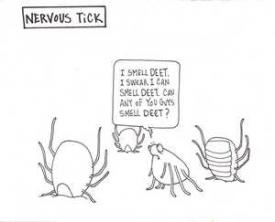NEWS: With ticks around, the hunter becomes the hunted

Tim Lockley, a retired USDA entomologist, gives tick advice to hunters in Mississippi.
Your Life – Columnists – Tim Lockley
Thursday, Nov. 11, 2010
With ticks around, the hunter becomes the hunted
Hunters tromp out into the woods this time of year never considering the fact that there are things out there hunting them.
Ticks are ambushers. They live a simple life waiting for a meal to wander close by. They don’t run. They don’t jump. They don’t fly. They just wait.
Ticks don’t have very good eyes. They can sense movement, and that’s just about it. Their primary way of detecting their prey is through the use of organs called Haller’s cups on their front legs. These organs allow them to sense the heat, carbon dioxide and odor given off by warm-blooded animals 3 or 4 yards away. If you find a tick crawling on your arm or in your hair, it climbed up there from somewhere around your ankles. When the message that a mammal is close by is sent to the tick’s tiny brain, it raises its front legs (which have hooks like claws), using its other legs to hold onto a blade of grass or a low twig. Once the unsuspecting host brushes by the tick’s perch, it uses its claws like grappling hooks and hitches a ride.
Read the rest of the article here.




















We invite you to comment on our Facebook page.
Visit LymeDisease.org Facebook Page